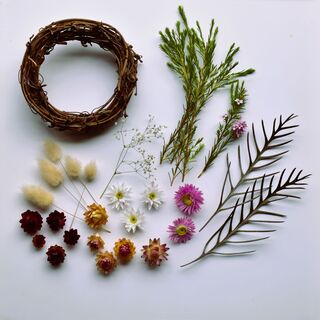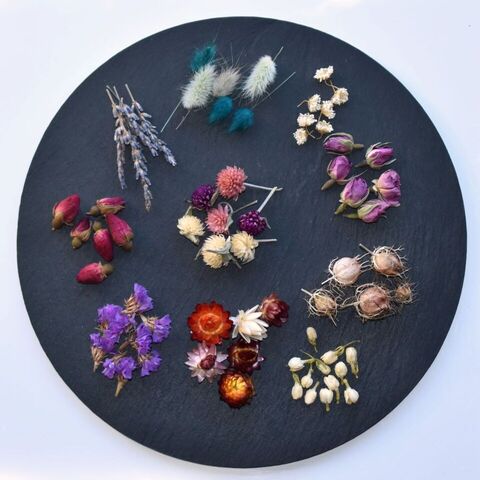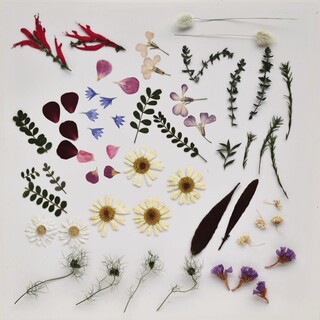Growing Mini Dried Flowers for Crafting
Growing Mini Dried Flowers for Crafting: A Complete Guide
Dried flowers have experienced a massive resurgence in popularity including mini dried flowers. Petite, delicate, and packed with character, these tiny blooms are perfect for all sorts of creative crafting — from resin jewelry and wax melts to tiny wreaths, pressed flower art, and botanical packaging.
In this guide, you’ll learn which flowers to grow, how to harvest and dry them, and how to use them across a range of popular crafts.
Why Choose Mini Dried Flowers?
Miniature dried flowers offer several advantages full-sized flowerheads:
- Perfect Scale for Small Crafts: Their size makes them ideal for delicate work such as resin art, handmade cards, soaps, jewelry, and candle embeds.
- Faster Drying Time: Smaller blooms dry more quickly and are less prone to mold.
- Easier to Store and Ship: They take up less space and hold up well when packed carefully.
- Unique Aesthetic: Tiny flowers bring a whimsical, fairy-tale charm to your projects.
Whether you’re crafting to sell or for your own enjoyment, mini dried flowers provide high visual impact in a manageable size.
Best Mini Flowers to Grow for Drying
Below is a list of easy-to-grow, craft-friendly mini flowers. These thrive in a range of climates (especially temperate zones like New Zealand, Australia, the UK, and much of the USA and Canada), dry well, and hold their shape and color after preservation.
Statice (Limonium sinuatum)
- Why it’s great: Statice comes in a rainbow of colors, dries perfectly, and has a papery texture that resists fading. They can also be easily cut down to a very small size.
- Mini Tip: Harvest when the flowers are just open and not wilting.
- Craft Uses: Wax melts, shadow boxes, potpourri, mini bouquets, pressed flowers.
Strawflower (Xerochrysum bracteatum)
- Why it’s great: Strawflowers have crisp petals and a long vase life, both fresh and dried.
- Mini Tip: Grow dwarf or compact cultivars like 'Tom Thumb' for small, tight blooms.
- Craft Uses: Resin jewelry, soap decoration, dried flower crowns, potpourri, wall art, glass domes.
- Harvesting: Harvest just as the flower is starting to loosen up in the petals, if you wait until they open, you’re too late and they will look old once dried (unless your going for a real vintage look)
Baby’s Breath (Gypsophila elegans)
- Why it’s great: Airy clusters of tiny white (or pink) blooms are a favorite filler flower.
- Mini Tip: Choose annual varieties for fast growth.
- Craft Uses: Pressed flower designs, candles, card making.
I’ll be honest, I’ve always struggled to grow Gypsophila, when I’ve managed to get blooms they’ve been a little underwhelming in size and not able to be used for long stems but it’s still great for small projects. I grow Bishops flowers for that whimsy white look instead with far greater success.
Bishops Flower (Ammi majus)
- Why it’s great: Can be used in tall dried stem arrangements or in small crafts with the dainty individual flowers.
- Mini Tip: Dry with longer stems upside down or they will dry droopy.
- Craft Uses: Pressed flower designs, candles, card making.
Globe Amaranth (Gomphrena globosa)
- Why it’s great: Holds vibrant color when dried and is compact naturally.
- Mini Tip: Pick before flowers fully open to retain a tidy, ball-like shape.
- Craft Uses: Mini bouquets, wreaths, resin pendants.
Lavender (Lavandula angustifolia)
- Why it’s great: Known for its fragrance and rustic elegance.
- Mini Tip: Use small individual florets or mini sprigs.
- Craft Uses: Soap and candle topping, bath salts, mini sachets.
- Variety: There are many varieties of lavender and in my opinion not all are suited for crafting as 1) some don’t hold their color and 2) some are too thick and not suitable for pressing. Munstead or Hicote where the blooms are slender and elegant are a good example for crafting.
Patio or Miniature Roses (Rosa)
- Why it’s great: An abundance of tiny rose buds or small vibrant rose petals.
- Mini Tip: Go for the pinks, darker yellows and reds as the whites and lighter colors tend to brown easily when drying.
- Craft Uses: Decorating soaps, candles, potpourri and card making.
Paper Cascade Daisy (Rhodanthe anthemoides – has been reclassified from ‘Helipterum)
- Why it’s great: The white petals and yellow centers hold shape well when dried.
- Mini Tip: Best when picked just before peak bloom. Just snip off flower head with short stem.
- Craft Uses: Presses very well for a range of crafts or can be used on wreaths, candles or soap
Bunny Tails (Lagurus ovatus)
- Why it’s great: Fluffy seed heads that dry beautifully and add texture.
- Mini Tip: Pick while fluffy and before the seeds drop. The heads are robust but the stems are delicate.
- Craft Uses: Larger heads can be used for Mini arrangements, botanical gifts or photo styling props but the smaller heads can be pressed and used for cards and more delicate crafts. I dye these and add to little jars around the home.
Cornflower Petals (Centaurea cyanus)
- Why it’s great: Petals offer an interesting shape for any pressed flower project.
- Mini Tip: Dry pressed flat otherwise the petals will curl. If growing to add as a sprinkle for cakes, soap or bath salts etc, you’ll need a lot of flowers to get enough petals.
- Craft Uses: Decorating soaps, candles, bath salts and cake decorating.
How to Grow Mini Dried Flowers
Soil & Site Selection
Most flowers on this list prefer:
- Full sun (at least 6 hours a day)
- Free-draining soil (amend clay with compost and sand)
- Shelter from strong wind (especially for tall stems)
Raised beds or containers work well, especially for small-scale gardens or urban settings.
Planting Tips
- Seed starting: Many mini flowers (like strawflower, statice, and globe amaranth) are best started from seed in trays, then transplanted once established.
- Spacing: Give each plant enough room to develop stems. This improves airflow, prevents disease, and results in more uniform flowers.
- Succession planting: Sow every 2–4 weeks for a continuous harvest.
Feeding & Maintenance
- Use a gentle, balanced organic fertilizer or compost tea every few weeks.
- Pinch back early growth to encourage bushier plants and more flower stems.
- Harvest frequently to encourage new blooms.
How to Harvest and Dry Mini Flowers
When to Harvest
I grow flowers specifically for drying and harvest either before or just as they are coming into full bloom. If you harvest at full bloom or after, you’ll find that the flower doesn’t hold its vibrant color when drying or it will just dry looking old and past it’s best.
- Pick just before full bloom for the longest-lasting dried results.
- Late afternoon is best.
- Choose healthy, blemish-free blooms for best dried flowers.
Drying Methods
1. Air Drying (Hanging)
- Strip leaves from stems.
- Bundle 5–10 stems together with a rubber band.
- Hang upside down in a dark, dry, well-ventilated space.
Drying time: 1–3 weeks depending on humidity and bloom size.
Best for: Statice Stems, Bishop Flowers, Lavender and Bunny Tails
2. Air Drying (Trays)
- Snip flower heads to leave a very small stem.
- Spread on a tray with a paper towel.
- Dry in a well-ventilated space, I’ve found that this does not need to be in the dark but if drying in the sun as soon as they’re dry store them away from sunlight.
Drying time: 7-10 days depending on humidity and bloom size.
Best for: Gomphrena, Strawflowers, Cascade Daisies and Rose Buds.
3. Pressing
- Place small blooms between two pieces of absorbent paper or baking paper inside a heavy book.
- Weight the book with additional heavy objects or use a flower press.
- Replace paper every few days to prevent mold.
Best for: Gypsophila, Statice pieces, Bishops flower and Cornflower petals.
Storage Tips
- Store dried flowers in a sealed container or cardboard box lined with tissue.
- Keep in a cool, dry place away from sunlight to prevent fading.
- Add a silica gel packet to control moisture.
- Keep an eye out for bugs as they will destroy your flowers in very short amount of time and they can be hard to spot in the drying process. LINK :SEE HERE FOR WHAT YOU CAN DO TO MINIMIZE BUG DAMAGE
Popular Crafts Using Mini Dried Flowers
1. Resin Jewelry
Tiny flowers suspended in resin make stunning earrings, pendants, and rings. Ideal blooms include Bishops flower tiny florets, statice pieces, gomphrena and small strawflowers .
Tip: Make sure flowers are fully dry before embedding to avoid discoloration or moisture bubbles.
2. Wax Melts & Botanical Candles
Add floral flair to the top layer of wax melts or as embeds in soy or beeswax candles. Lavender, baby’s breath, cornflower petals and rose buds are popular picks.
3. Pressed Flower Art & Stationery
Create flat floral collages, greeting cards, bookmarks, and framed botanical prints with pressed flowers.
4. Mini Wreaths & Wall Décor
Make charming miniature wreaths using bunny tails, strawflowers, lavender, and baby’s breath. These are great for wall hangings, gift embellishments, or even holiday decorations.
5. Gift Packaging and Labels
Glue dried blooms to kraft paper tags, tuck sprigs under twine, or use small pressed flowers on product labels for a beautiful natural touch.
6. Potpourri & Sachets
Fragrant flowers like lavender and rose petals can be mixed with strawflowers, citrus peels and essential oils to create custom blends.
Posted: Wednesday 16 July 2025



